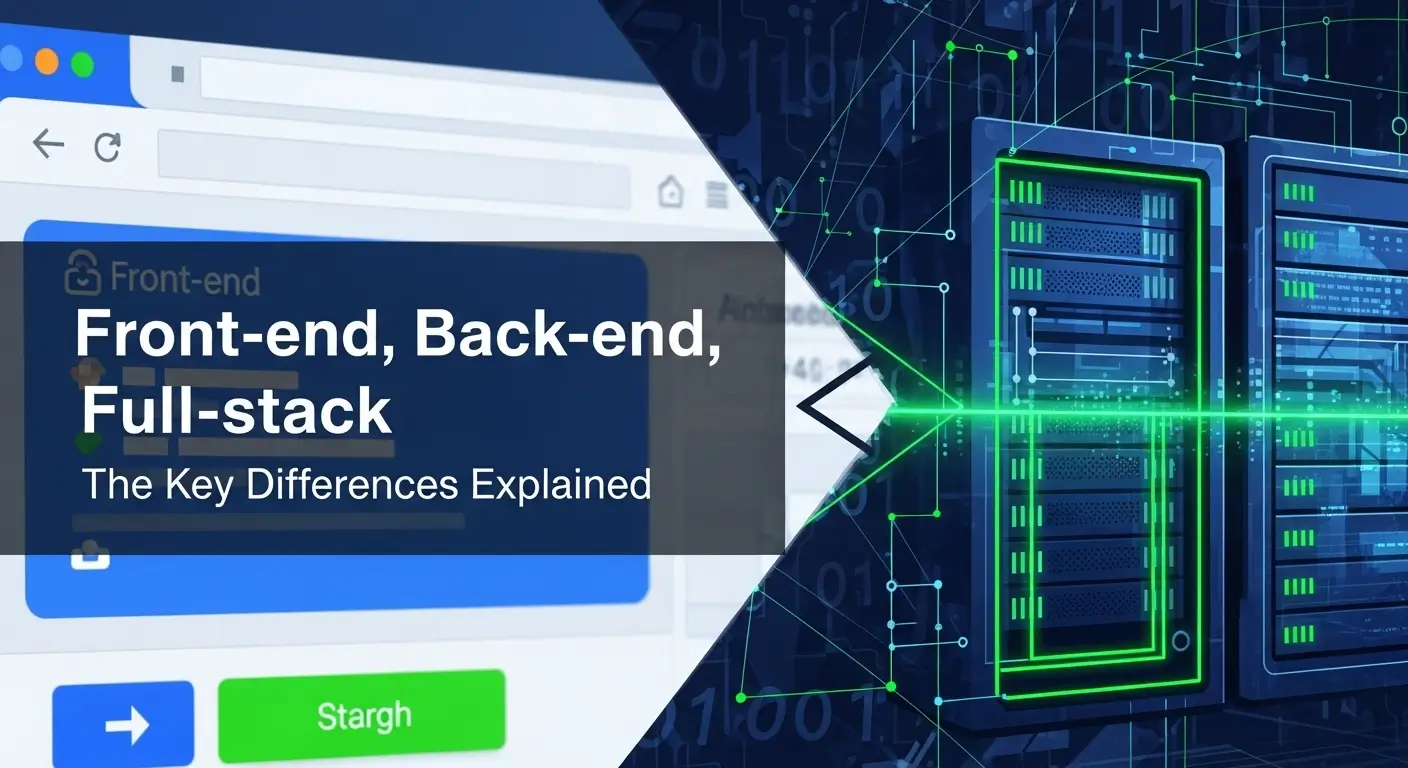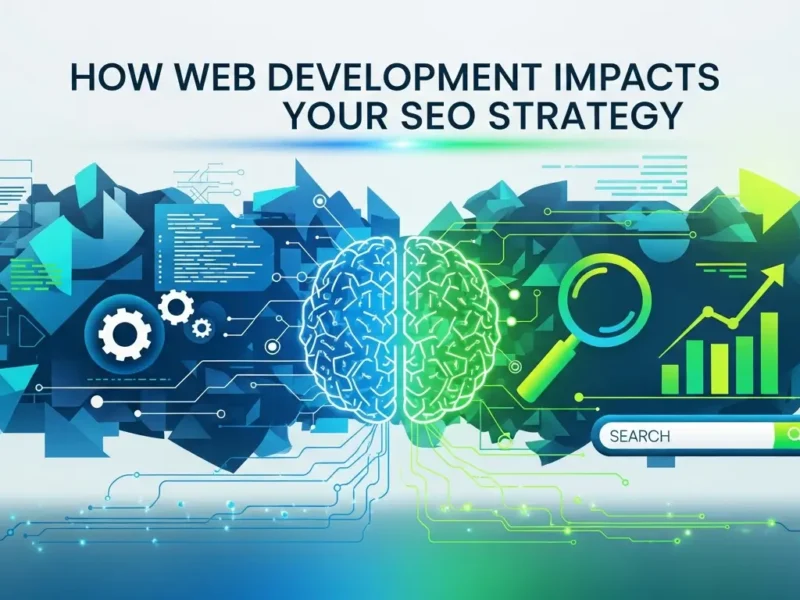In the vast and ever-evolving landscape of web development, terms like “Front-end,” “Back-end,” and “Full-stack” are thrown around constantly. While they all pertain to building websites and applications, they represent distinctly different specializations within the development process. For aspiring developers, project managers, or anyone curious about the digital world, understanding these key differences is crucial. This article will demystify these roles, break down their responsibilities, technologies, and help you understand which path might be right for you.
The Foundation: Understanding Web Development Layers
Before diving into the specifics of each role, it’s helpful to visualize a website or application as having two primary layers:
- The Client-Side (Front-end): This is everything you see and interact with directly in your web browser – the buttons, text, images, forms, and overall layout. It’s the user interface (UI) and user experience (UX) layer.
- The Server-Side (Back-end): This is the invisible engine working behind the scenes. It handles data storage, application logic, security, and ensures the client-side can function properly by feeding it the necessary information.
With this distinction in mind, let’s explore the roles.
Diving Deep into Front-End Development
A Front-end Developer is essentially the architect and interior designer of the web. Their primary focus is on the client-side of a website or application, ensuring that everything users see and interact with is visually appealing, intuitive, and responsive. They translate design concepts into interactive digital experiences. Many agencies offer comprehensive front end development services to clients looking to build engaging user interfaces.
Key Responsibilities:
- User Interface (UI) Development: Building the graphical elements and layouts of a website.
- User Experience (UX) Implementation: Ensuring the site is easy to navigate, enjoyable to use, and functions seamlessly across various devices and browsers.
- Responsiveness: Making sure the website adapts beautifully to different screen sizes, from desktops to mobile phones.
- Performance Optimization: Ensuring the website loads quickly and efficiently.
- Interaction Design: Implementing animations, transitions, and other interactive elements.
Core Technologies & Skills:
- HTML (HyperText Markup Language): The standard language for creating web pages and defining their structure.
- CSS (Cascading Style Sheets): Used for styling the appearance of web pages, including colors, fonts, layout, and responsiveness.
- JavaScript: The programming language that makes websites interactive, enabling dynamic content, animations, and complex functionalities.
- Frameworks & Libraries: Tools built on JavaScript to streamline development, such as React, Angular, and Vue.js.
- UI/UX Principles: A strong understanding of design principles, usability, and accessibility.
- Browser Developer Tools: For debugging and inspecting web pages.
Think of a front-end developer as the one who crafts the exquisite facade and functional rooms of a building, making it beautiful and user-friendly for its occupants. They are vital for creating engaging digital experiences.
Unpacking Back-End Development
In contrast to the front-end, a Back-end Developer operates behind the scenes, focusing on the server, application, and database that power a website. They are the masterminds responsible for the logic, functionality, and performance that users never directly see but heavily rely upon. Their work ensures data is stored, retrieved, and processed correctly, and that the application runs smoothly and securely. Companies often seek specialized backend development services to build robust, scalable, and secure server-side solutions for their applications.
Key Responsibilities:
- Server-Side Logic: Building the “brain” of the application, including business logic and algorithms.
- Database Management: Designing, building, and managing databases to store and retrieve information efficiently.
- API Development: Creating Application Programming Interfaces (APIs) that allow the front-end to communicate with the back-end and external services.
- Security: Implementing measures to protect data and user information.
- Server Deployment & Maintenance: Configuring and managing servers to host the application.
- Scalability: Ensuring the application can handle increased user loads.
Core Technologies & Skills:
- Programming Languages: Python (with frameworks like Django, Flask), Java (Spring Boot), Node.js (Express.js), Ruby (Ruby on Rails), PHP (Laravel), C# (.NET).
- Databases: SQL databases (PostgreSQL, MySQL, SQL Server) and NoSQL databases (MongoDB, Cassandra).
- APIs: RESTful APIs, GraphQL.
- Server Management: Understanding of web servers (Apache, Nginx) and cloud platforms (AWS, Azure, Google Cloud).
- Security Best Practices: Knowledge of authentication, authorization, and data encryption.
A back-end developer is like the structural engineer and utility manager of our building analogy. They design the foundation, build the plumbing, electrical systems, and ensure the entire structure is sound, secure, and functional, even if their work isn’t immediately visible.
The All-Rounder: Full-Stack Development
A Full-stack Developer is the versatile expert who can work on both the front-end and back-end of an application. They possess a comprehensive understanding of how the entire system works, from the user interface to the server logic and database management. This makes them incredibly valuable, especially in smaller teams or startups where a broad skill set is essential. These developers often provide holistic full stack development services, overseeing a project from conception to completion across all layers.
Key Responsibilities:
- End-to-End Development: Managing all aspects of a project, from initial design to deployment and maintenance.
- System Architecture: Designing how different parts of an application will communicate and function together.
- Troubleshooting: Diagnosing and fixing issues across the entire software stack.
- Team Collaboration: Bridging the communication gap between specialized front-end and back-end teams.
Core Technologies & Skills:
Full-stack developers typically master a “stack” of technologies, which might include:
- Front-end: HTML, CSS, JavaScript (and one framework like React/Angular/Vue).
- Back-end: A programming language (e.g., Python, Node.js) with its associated framework (e.g., Django, Express) and a database (e.g., PostgreSQL, MongoDB).
- DevOps Basics: Understanding of deployment, version control (Git), and potentially cloud services.
Returning to our building analogy, a full-stack developer is the general contractor. They oversee everything from laying the foundation and installing the utilities to designing the interiors and ensuring the paint job is perfect. They have a holistic view of the entire project and can step in to work on any component.
Front-End vs. Back-End vs. Full-Stack: A Quick Comparison
| Feature | Front-end Developer | Back-end Developer | Full-stack Developer |
|---|---|---|---|
| Focus | User Interface (UI) & User Experience (UX) | Server, Database, Application Logic, Security | Both UI/UX and Server/Database/Logic |
| Role | Client-side development | Server-side development | End-to-end development |
| Output | Interactive web pages, responsive designs | Functional APIs, data storage, robust logic | Complete, fully functional web applications |
| Key Skills | Design, aesthetics, usability, responsiveness | Logic, data structures, algorithms, security | Versatility, problem-solving, broad tech knowledge |
| Core Tech | HTML, CSS, JavaScript (React, Angular, Vue) | Python, Java, Node.js (Django, Spring, Express), SQL, NoSQL | Blend of front-end and back-end technologies |
Which Path is Right for You?
Choosing between these web development roles depends on your interests, strengths, and career aspirations:
- Choose Front-End if you enjoy visual design, user psychology, creating intuitive interfaces, and seeing immediate visual results from your code. You love bringing static designs to life and ensuring a delightful user experience.
- Choose Back-Endif you’re fascinated by complex logic, data management, problem-solving, system architecture, and working with powerful server-side technologies. You thrive on building the robust foundations that make applications functional and secure.
- Choose Full-Stackif you have a strong desire to understand the entire development process, enjoy switching between different types of tasks, and love the challenge of building a complete product from scratch. It requires continuous learning but offers immense versatility.
Many developers start by specializing in either front-end or back-end and gradually expand their skills to become full-stack over time.
Conclusion
The world of web development offers diverse and rewarding career paths. Whether you choose to specialize in the visible artistry of front-end development, master the intricate logic of back-end development, or embrace the comprehensive challenge of full-stack development, each role is indispensable to building the sophisticated digital experiences we use every day. Understanding these key differences is your first step towards navigating this exciting industry.



